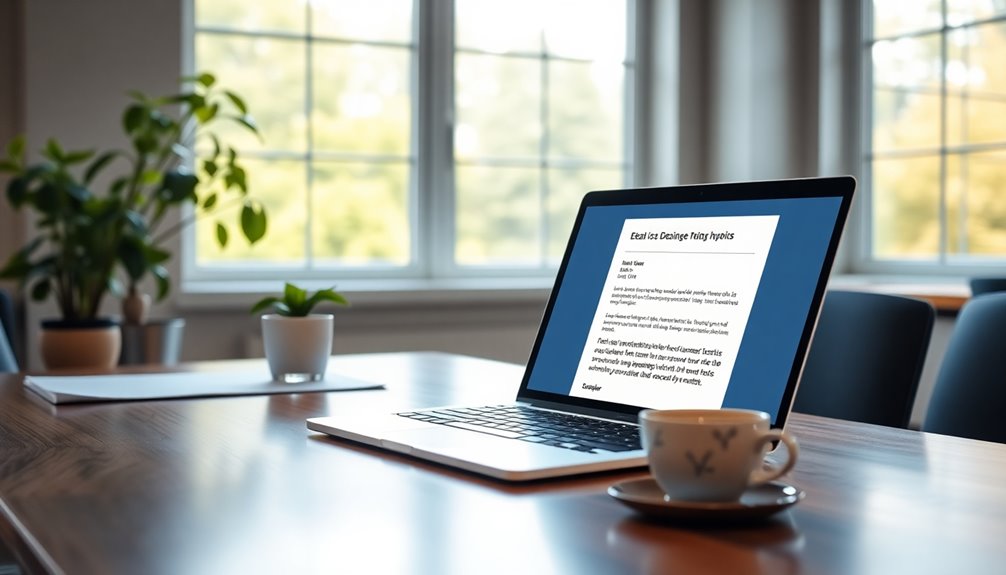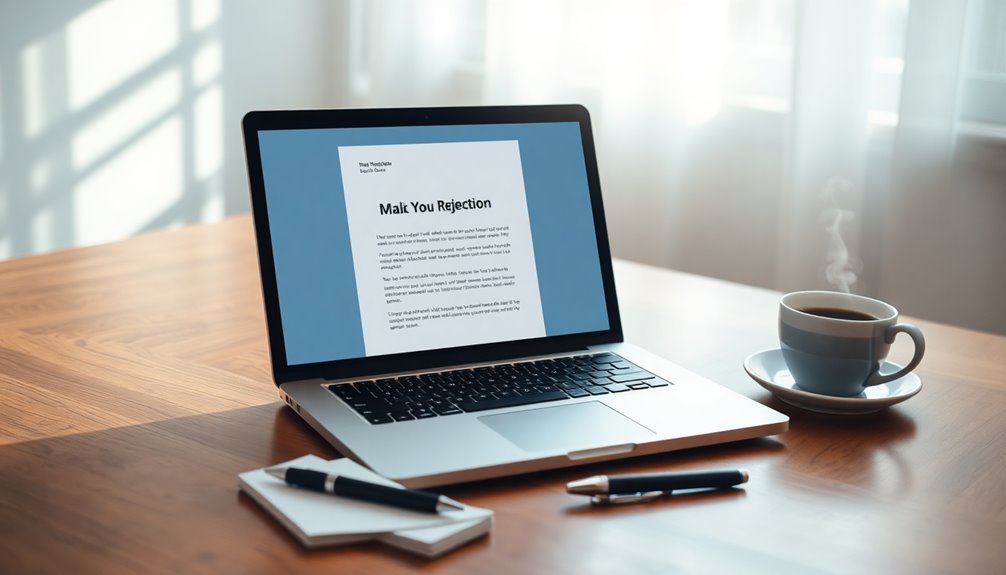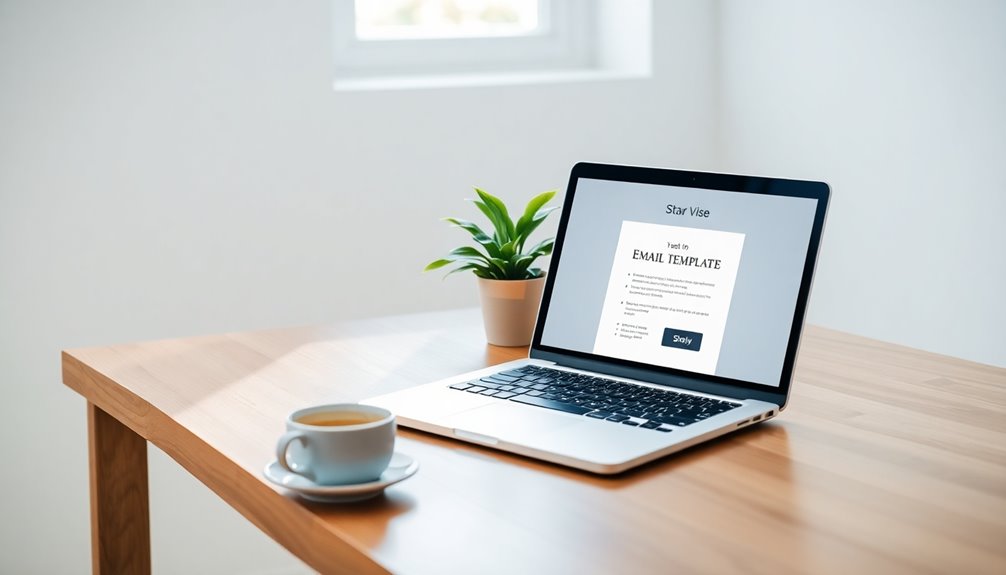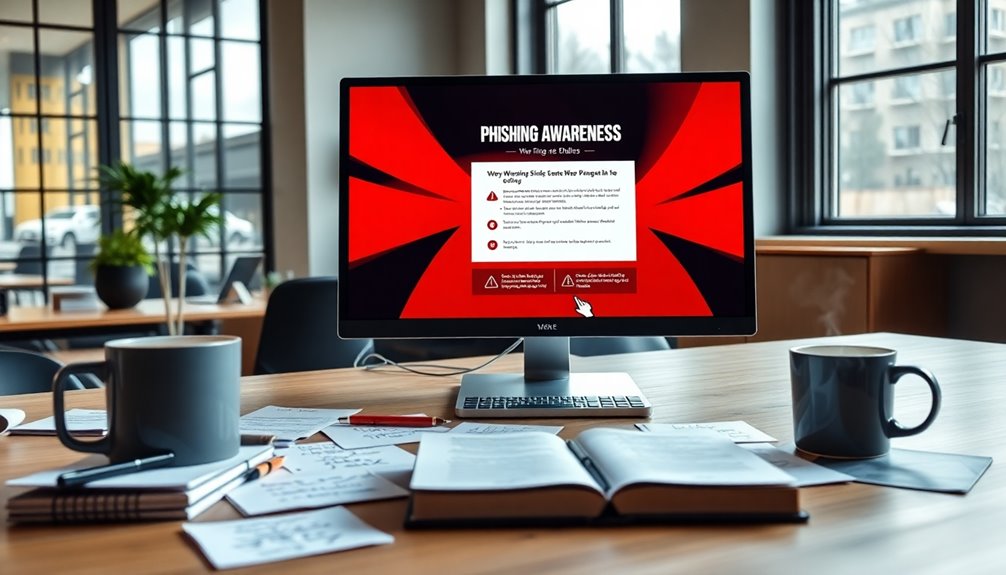To reject customer requests politely, start your email with gratitude to acknowledge their effort. Clearly state your inability to fulfill the request and provide valid reasons to enhance understanding. Use empathetic language, like "I understand your concern," to soften the impact of your rejection. Offering alternative solutions or inviting questions fosters open communication and shows you value their input. End your email on a positive note to maintain goodwill and encourage future interactions. This approach builds trust and strengthens relationships. If you want to discover the complete process and get more tips, keep going!
Key Takeaways
- Start your email by expressing gratitude for the customer's interest to set a respectful tone.
- Clearly state the inability to fulfill the request while providing valid reasons for transparency.
- Use empathetic language to acknowledge the customer's feelings and soften the impact of the rejection.
- Suggest alternative solutions or future collaboration opportunities to keep the conversation open.
- End on a positive note, reinforcing your commitment to customer satisfaction and encouraging future engagement.
Introduction

In today's customer-centric world, knowing how to reject requests politely is crucial for maintaining strong relationships. When you receive a request that can't be fulfilled, how you respond can make all the difference. Polite rejection doesn't just help you avoid conflict; it enhances overall customer satisfaction and keeps the lines of communication open.
Using a well-structured email template can guide your approach, ensuring clarity and professionalism. Start by expressing gratitude for the customer's engagement. This sets a respectful tone that makes them more receptive to your message.
Next, provide a valid explanation for the refusal, fostering transparency. This helps the customer understand your decision rather than feeling dismissed.
Don't forget to suggest alternative solutions or future opportunities. By doing this, you demonstrate your commitment to customer satisfaction and engagement. You're not just shutting the door; you're also keeping the window open for future conversations.
Builds Trust With Customers

Building trust with customers is essential for any successful business relationship, especially when you need to decline a request. When you send a polite rejection email, expressing gratitude for the customer's interest sets a respectful tone. This approach not only fosters trust but also shows that you value their engagement.
Providing a clear and honest explanation for your decision demonstrates transparency, helping customers understand your reasoning. Additionally, incorporating natural language processing can enhance the clarity and personalization of your communication.
Moreover, suggesting alternative solutions or opportunities for the future highlights your commitment to excellent customer service. It reassures customers that, while their current request may not be feasible, you're still invested in their satisfaction. This proactive stance enhances their perception of your business and builds long-term loyalty.
Maintaining a professional tone throughout your communication reinforces the customer's value. By following up with an invitation for further questions or assistance, you encourage open dialogue. Additionally, ensuring your approach aligns with the importance of transparency in fee structures helps further solidify the trust between you and your customers.
This openness solidifies the trust between you and your customers, showing them that you're always available to help. In the end, these strategies enhance your relationship and ensure customers feel respected, even when you have to say no.
Empathetic Language Throughout Email

Acknowledging a customer's feelings is key when delivering a rejection. Using empathetic language throughout your email helps you connect with the customer, demonstrating genuine care and understanding during a disappointing situation.
When you say things like, "I understand your concern," or "I appreciate your request," you soften the blow of the rejection and show that you value their needs.
Empathy in your response can significantly enhance customer satisfaction and retention, even when you have to decline the request. A sincere apology paired with empathetic wording can help mitigate any negative feelings and maintain a positive relationship.
It's important to remember that your tone sets the stage for how the customer perceives your customer support.
Closing your email by inviting further questions or offering additional assistance reinforces your commitment to customer care. This way, despite the refusal, you keep the lines of communication open, showing that you're still here for them.
Crafting a Rejection Email

Crafting a rejection email requires a careful balance of honesty and kindness. Start by expressing gratitude for the customer's interest. Acknowledge their request to set a respectful tone.
When you need to reject a customer request, be clear and direct about your inability to fulfill it. Avoid vague language to prevent any confusion.
Next, provide a valid reason for your refusal. Being transparent helps the customer understand your situation better and makes the rejection feel less personal.
After that, suggest alternative solutions or opportunities for future collaboration. This shows you value the relationship and are open to working together down the line.
Close your email on a positive note. Reinforce goodwill by encouraging the customer to reach out if they've any further questions or need assistance. You might say, "If you have any other ideas or requests, let's know. We're here to help!"
This leaves the door open for future interactions and helps maintain a positive connection, even after a rejection. By following these steps, you can craft an effective rejection email that communicates your message with compassion and clarity.
Pro Tips for Maximizing Impact

To maximize the impact of your rejection email, start by understanding the customer's perspective. Recognize their motivations and the context behind their customer requests. Use the ASK-THINK-SAY framework to guide your response, ensuring you address their needs before stating your limitations.
Begin your email by expressing gratitude for their interest; this sets a respectful tone and shows you value their input.
When you explain why you're unable to offer what they requested, be clear and transparent. This helps the customer understand your position and makes it easier for them to accept the decision.
Don't leave the conversation closed. Offer alternative solutions or suggest possibilities for the future. This not only keeps the door open but also demonstrates your willingness to maintain a relationship.
Throughout the email, maintain a professional and empathetic tone. This leaves a positive impression and encourages future interactions.
Common Mistakes to Avoid

Many businesses make critical mistakes when rejecting customer requests, which can harm relationships.
First, failing to express gratitude at the beginning of your email can make the customer feel undervalued. Always thank them for their input; it shows you appreciate their effort.
Next, be clear in your explanation for why you reject the customer's request. If your reasoning is vague, it may confuse or frustrate them, leading to a negative impression.
Additionally, don't miss the chance to suggest alternative solutions or features that might meet their needs. This shows you're taking the time to support them, rather than just shutting the door.
A negative or abrupt tone can also leave a lasting impression; maintain a professional and empathetic communication style throughout your message.
Lastly, offer avenues for future engagement or feedback. Ignoring this opportunity can limit the chances of a positive relationship moving forward.
By avoiding these common mistakes, you can reject the customer's request while still fostering goodwill and maintaining a constructive dialogue.
Refund Request Email Template

Finally, conclude the email by inviting further questions or concerns. Phrasing it as, "Please feel free to reach out if you need any more assistance," reinforces your willingness to help. Additionally, understanding filial responsibility laws can help in addressing any potential financial concerns that may arise from customer disputes. Using this refund request email template can ensure you respond with professionalism and care while keeping your customers engaged. Furthermore, being aware of financial misconduct can assist in navigating customer interactions effectively.
Final Thoughts

Navigating customer requests can feel like walking a tightrope, especially when you have to say no. You need to know that using a structured email template can help you maintain professionalism and clarity during these tricky conversations.
Start your email with gratitude; this sets a positive tone and acknowledges the effort the customer put into reaching out.
When telling us about your inability to fulfill a request, clearly state your reasons. This transparency makes it easier for customers to accept your decision.
If possible, offer alternative solutions or express your willingness for future collaborations. This not only softens the rejection but also keeps the door open for future interactions. Remember, clear communication is essential in any rejection to ensure mutual understanding and respect.
Frequently Asked Questions
How to Reject Customer Request Politely Email Template?
When you need to reject a customer request, start by expressing gratitude for their interest. Clearly explain your inability to fulfill their request, then offer alternatives and invite further questions to maintain a positive relationship.
How to Reject a Request Politely in Email?
When you need to reject a request in an email, express gratitude first. Clearly explain your inability to fulfill it, offer alternative solutions, and invite future questions to keep the communication open and positive.
How Will You Write an Email When a Customer Is Being Rejected for Something?
When writing an email to reject a customer's request, express gratitude for their interest, clarify your inability to fulfill it, provide a valid reason, suggest alternatives, and offer assistance for future needs. Keep it positive!
How Do I Say "Not Interested" Politely in an Email?
When you want to say "not interested" politely in an email, express appreciation, clearly explain your position, and suggest alternatives. Always maintain a respectful tone to keep the relationship positive and open for future interactions.









